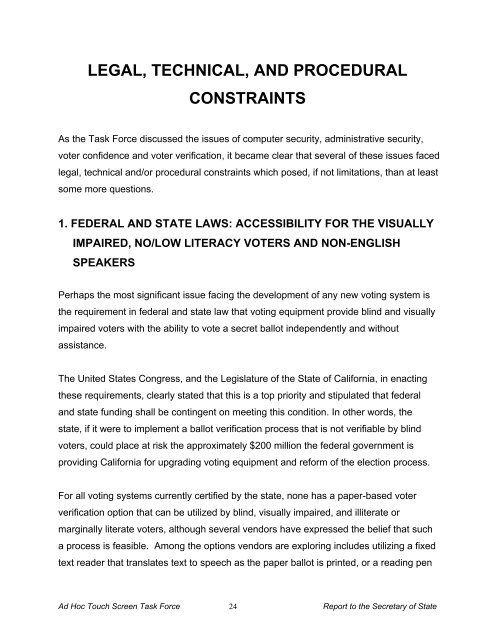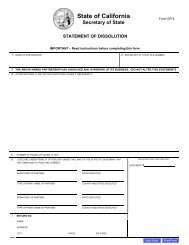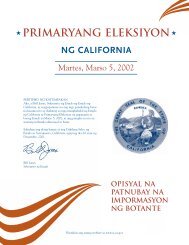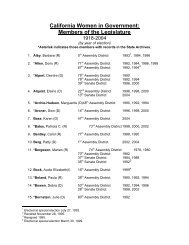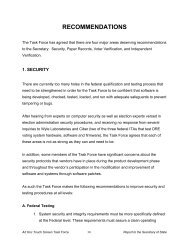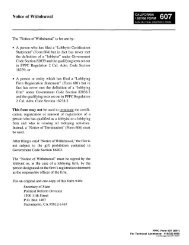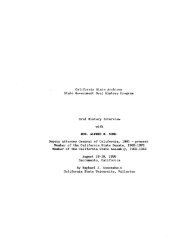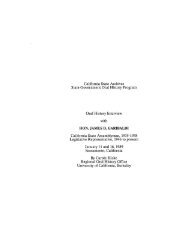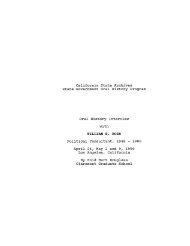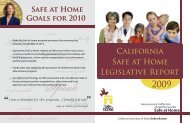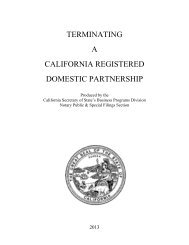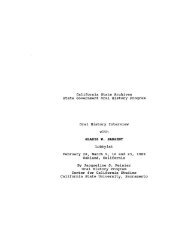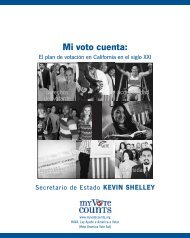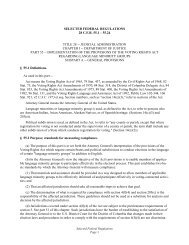legal, technical, and procedural constraints - California Secretary of ...
legal, technical, and procedural constraints - California Secretary of ...
legal, technical, and procedural constraints - California Secretary of ...
Create successful ePaper yourself
Turn your PDF publications into a flip-book with our unique Google optimized e-Paper software.
LEGAL, TECHNICAL, AND PROCEDURAL<br />
CONSTRAINTS<br />
As the Task Force discussed the issues <strong>of</strong> computer security, administrative security,<br />
voter confidence <strong>and</strong> voter verification, it became clear that several <strong>of</strong> these issues faced<br />
<strong>legal</strong>, <strong>technical</strong> <strong>and</strong>/or <strong>procedural</strong> <strong>constraints</strong> which posed, if not limitations, than at least<br />
some more questions.<br />
1. FEDERAL AND STATE LAWS: ACCESSIBILITY FOR THE VISUALLY<br />
IMPAIRED, NO/LOW LITERACY VOTERS AND NON-ENGLISH<br />
SPEAKERS<br />
Perhaps the most significant issue facing the development <strong>of</strong> any new voting system is<br />
the requirement in federal <strong>and</strong> state law that voting equipment provide blind <strong>and</strong> visually<br />
impaired voters with the ability to vote a secret ballot independently <strong>and</strong> without<br />
assistance.<br />
The United States Congress, <strong>and</strong> the Legislature <strong>of</strong> the State <strong>of</strong> <strong>California</strong>, in enacting<br />
these requirements, clearly stated that this is a top priority <strong>and</strong> stipulated that federal<br />
<strong>and</strong> state funding shall be contingent on meeting this condition. In other words, the<br />
state, if it were to implement a ballot verification process that is not verifiable by blind<br />
voters, could place at risk the approximately $200 million the federal government is<br />
providing <strong>California</strong> for upgrading voting equipment <strong>and</strong> reform <strong>of</strong> the election process.<br />
For all voting systems currently certified by the state, none has a paper-based voter<br />
verification option that can be utilized by blind, visually impaired, <strong>and</strong> illiterate or<br />
marginally literate voters, although several vendors have expressed the belief that such<br />
a process is feasible. Among the options vendors are exploring includes utilizing a fixed<br />
text reader that translates text to speech as the paper ballot is printed, or a reading pen<br />
Ad Hoc Touch Screen Task Force 24 Report to the <strong>Secretary</strong> <strong>of</strong> State
that would allow a blind voter to scan a pen across the paper print-out <strong>and</strong> hear the<br />
words spoken via a speech synthesis component in the pen.<br />
Federal law also requires jurisdictions in <strong>California</strong> to produce election materials in<br />
languages other than English. The County <strong>of</strong> Los Angeles, for example, is required to<br />
provide ballots in English, Spanish, Chinese, Vietnamese, Tagalog, Japanese, <strong>and</strong><br />
Korean. And Riverside County has a Cahuilla language requirement that is strictly an<br />
oral language <strong>and</strong> has no written form. Providing a paper-based representation <strong>of</strong><br />
ballots in all these languages is also an important issue, as is the question <strong>of</strong> whether<br />
the paper-based representation must represent the ballot in English as well as the<br />
second language so that election <strong>of</strong>ficials can read the document.<br />
The Task Force agrees that voting equipment should <strong>and</strong> must meet the requirements<br />
<strong>of</strong> federal <strong>and</strong> state laws requiring access to voting.<br />
2. COURT ORDERED CONVERSION<br />
A federal court order on the <strong>Secretary</strong> <strong>of</strong> State to assure that there are no pre-scored<br />
punch card systems in use in <strong>California</strong> beyond January 1, 2004, means that nine <strong>of</strong><br />
<strong>California</strong>’s counties must replace their punch card voting systems by that date. This<br />
can only be accomplished in conjunction with <strong>legal</strong> requirements for contracting <strong>and</strong><br />
purchasing <strong>and</strong> the time limitations on state <strong>and</strong> federal certification <strong>of</strong> voting systems.<br />
For example, as <strong>of</strong> now, no voting systems currently certified by the state that provide<br />
for voting secretly <strong>and</strong> independently by persons who are blind include a voter<br />
verification option that the blind can utilize.<br />
The Task Force agrees that the conversion process required by the presidential<br />
elections in 2004 must not be compromised <strong>and</strong> that its recommendations not<br />
undermine the successful preparation <strong>and</strong> administration <strong>of</strong> the upcoming March 2,<br />
2004 primary election.<br />
Ad Hoc Touch Screen Task Force 25 Report to the <strong>Secretary</strong> <strong>of</strong> State
3. PRODUCT DEVELOPMENT AND TESTING CHALLENGES<br />
In order for a county to purchase a system, the vendor would first have to develop it,<br />
submit it to national testing laboratories for security <strong>and</strong> other testing, <strong>and</strong> submit it to<br />
the state for similar testing <strong>and</strong> evaluation. In addition, the counties would have to issue<br />
Requests For Proposal, accept bids, analyze the bids, <strong>and</strong> negotiate a contract. Many<br />
counties are implementing a new voting system for local elections in November <strong>of</strong> 2003,<br />
only six months from the date <strong>of</strong> this report.<br />
The Task Force agrees that the time requirements for product development <strong>and</strong><br />
certification are significant issues in terms <strong>of</strong> the timing <strong>of</strong> the development <strong>of</strong> potential<br />
market solutions to address any <strong>of</strong> the issues brought up in this report.<br />
4. DISASTER AVOIDANCE<br />
Implementation <strong>of</strong> a new voting system requires – in order to avoid the missteps in the<br />
Florida 2002 election – significant time to train county personnel, train poll workers,<br />
educate the voters concerning the new voting systems, <strong>and</strong> otherwise prepare for the<br />
election. The likelihood that all <strong>of</strong> the steps outlined above could be accomplished in<br />
time to successfully install the equipment <strong>and</strong> successfully conduct an election in<br />
November 2003 is extremely remote.<br />
The Task Force agrees that the presidential elections in 2004 must not be<br />
compromised, that any recommendations to change current voting equipment recognize<br />
the paramount importance <strong>of</strong> a successful election in terms <strong>of</strong> voter confidence, <strong>and</strong><br />
that its recommendations not undermine the successful administration <strong>of</strong> those<br />
elections.<br />
Ad Hoc Touch Screen Task Force 26 Report to the <strong>Secretary</strong> <strong>of</strong> State
5. VOTER ISSUES<br />
The <strong>California</strong> Constitution requires that voting be secret. Voting systems that rely on a<br />
“reel to reel” paper tape potentially order ballots sequentially, <strong>and</strong> could be amenable to<br />
efforts to determine which voter cast which ballot. In addition, in the absence <strong>of</strong><br />
additional voting stations, there is the potential for increasing the time it takes to vote,<br />
creating longer lines at polling places, <strong>and</strong> discouraging voters from casting ballots.<br />
There is unanimous concern on the Task Force that any proposed method <strong>of</strong><br />
verification not inconvenience voters, create lines at the polling place, or otherwise<br />
discourage voters from casting a ballot.<br />
6. ELECTION ADMINISTRATION<br />
The recruitment <strong>and</strong> training <strong>of</strong> nearly 100,000 mostly elderly poll workers for a<br />
statewide election is a major undertaking under current circumstances. Requiring more<br />
complex equipment naturally raises concerns over poll worker recruitment, training,<br />
mechanical reliability, ongoing operational costs, <strong>and</strong> voter frustration. These concerns<br />
need to be considered.<br />
The Task Force agrees that new equipment options should be as simple to administer<br />
as possible so as to not create unnecessary complexity at the polling place.<br />
7. PRINTER ISSUES<br />
One method discussed is to create a paper record <strong>of</strong> the vote for each voter to verify his<br />
or her ballot choices. This requires that a printer be added to the voting machine. The<br />
voting machine can produce the printed version <strong>of</strong> the ballot when the voter casts his or<br />
her ballot, when the polls close, or as required for the 1% manual recount. The latter<br />
two <strong>of</strong> these options are currently available on <strong>California</strong>-certified DRE systems.<br />
Ad Hoc Touch Screen Task Force 27 Report to the <strong>Secretary</strong> <strong>of</strong> State
Printers at polling places potentially create several significant election administration<br />
problems, including: (1) added cost to the system; (2) printer jams or other malfunctions<br />
requiring poll worker intervention; (3) added weight to the voting equipment; (4) current<br />
inaccessibility <strong>of</strong> the paper verification option to persons who are blind, visually<br />
impaired, illiterate, marginally literate, or are oral language restricted; (5) need for<br />
printers to print in foreign language characters; (6) more equipment that poll workers<br />
need to be trained to use <strong>and</strong> troubleshoot any problems; (7) more equipment for each<br />
jurisdiction to store, transport <strong>and</strong> maintain; <strong>and</strong> (8) additional supplies <strong>and</strong> warehousing<br />
procedures required to account for “<strong>of</strong>ficial” ballot paper requirements.<br />
The Task Force agrees that there are a number <strong>of</strong> logistical challenges that are present<br />
with any paper-based voting system using printers <strong>and</strong> these challenges need to be<br />
explored <strong>and</strong> understood in greater detail.<br />
8. MARKETPLACE<br />
As noted, there are currently no voting systems that <strong>of</strong>fer paper-based voter verification<br />
procedures that provide persons who are blind or visually impaired with the ability to<br />
verify their ballot. Systems currently available, either as certified systems or as<br />
prototypes, rely on paper for a voter to verify the electronic record. The marketplace is<br />
potentially capable <strong>of</strong> addressing the <strong>technical</strong> issues with printers <strong>and</strong> poll workers<br />
listed above as well as producing solutions to achieving voter verification without<br />
utilizing paper.<br />
The Task Force agrees that local jurisdictions should have a range <strong>of</strong> verification option<br />
to choose from, including paper-based <strong>and</strong> electronic options.<br />
9. REIMBURSEMENT<br />
As mentioned above, several counties have already purchased DRE voting equipment.<br />
New st<strong>and</strong>ards have been developed by the FEC <strong>and</strong> newer st<strong>and</strong>ards may be<br />
Ad Hoc Touch Screen Task Force 28 Report to the <strong>Secretary</strong> <strong>of</strong> State
developed by NIST. This presents potentially significant issues <strong>of</strong> funding <strong>and</strong><br />
reimbursement, <strong>and</strong> raises the issue <strong>of</strong> the timing <strong>of</strong> any requirement for implementing<br />
new st<strong>and</strong>ards or acquiring new equipment.<br />
The Task Force agrees that state or federal funds should be provided to pay the cost <strong>of</strong><br />
upgrading any system that does not meet the requirements implemented as a result <strong>of</strong><br />
the recommendations <strong>of</strong> this report.<br />
Ad Hoc Touch Screen Task Force 29 Report to the <strong>Secretary</strong> <strong>of</strong> State


